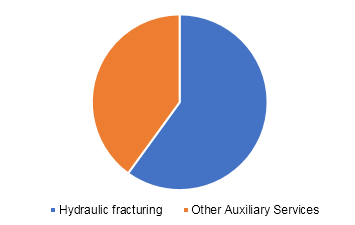
U.S. Hydraulic Fracturing Market Size And Forecast By Service Type (Hydraulic Fracturing, Other Auxiliary Services) By End-Use (Oil & Gas Extraction) And Trend Analysis, 2015 - 2025
- Published: April, 2018
- Format: Electronic (PDF)
- Number of pages: 50
- Industry: Energy & Power
Industry Insights
The U.S. hydraulic fracturing market size was valued at USD 9.6 billion in 2017 and is expected to witness a significant growth, pertaining to the growing oil and gas extraction activities over the forecast period. The U.S. hydro fracking market is primarily driven by the high demand of energy and the rise in the need of natural gas and oil resources in the country. The persistent exhaustion of shallow water and onshore fields have constrained oil companies to put an emphasis on unconventional onshore and deep water zones where a hydraulic fracturing services are needed for the extraction of oil and gas. With the rise in the abundant shale reserves exploration in the country the requirement for hydraulic fracturing is growing. Hydraulic fracturing is a method of proliferating fractures on reservoirs with low-permeability such as shale to escalate the flow of oil and gas during production processes.
U.S. Hydraulic fracturing market revenue split, by service type, 2017 (% share)

Fluids and proppants, are inoculated at high flow rate and pressure into the reservoirs to produce fractures on the wellbore. Hydraulic fracturing helps to construct adequate penetrability through the reservoir to remove oil & gas which is very challenging to extract from natural production processes. The hydraulic fracturing technique emerged after the U.S. shale gas revolution which is now playing a vital role in unconventional oil & gas production and exploration activities.
Segmentation by service type
• Hydraulic fracturing
• Other Auxiliary Services
The demand for hydraulic fracturing is high as compared to other auxiliary services owing to the frequent use of this process for oil and gas extraction especially the growing availability of shale gas as a natural gas source, which has further led to the rise in the hydro fracking technology and horizontal drilling in the country. Hydraulic fracturing is used for the extraction of hydrocarbons from conventional and unconventional reservoirs. It escalates the flow of oil and gas from a reservoir by pumping liquids with high pressures into the subsurface rock units which is strong enough to fracture the rock. It forms a grid of interconnected fractures which function as spaces with pores to enable the movement of natural gas and oil to the well bore. With the rise in the oil and gas activities in the U.S. the market is expected to grow rapidly over the forecast period.
There are various materials used for hydro fracking such as proppants, ceramic materials and various chemicals, which are employed during the process and maintain the induced fractures which allows easy movement of fluids amongst the wellbores. Ceramics, sand, and resin coated sand are majorly used as proppants for hydrofracking activities. Sand is widely used owing to its cheap and easy availability.
Hydraulic fracturing is mainly done using various technologies such as plug & perf, and sliding sleeve technologies. The plug & perf technology is employed to extract and remove oil & gas from cased holes. Sliding sleeve is comparatively a new technology which is less time consuming and more effective and used for the extraction of oil and gas from openhole wellbores and naturally fractured formations and reservoirs. Both of the technologies are either applied in combination which is referred as ‘hybrid frac’ or distinctly, subject to the fracture quality, cost and formation type. Plug & Perf technology is employed more in horizontal wells on high quality fractures.
Segmentation by end-use
• Oil & gas extraction
• Others
The hydraulic fracturing in the oil & gas extraction segment occupies a major market share and is expected to grow its dominance over the forecast period. Rapid industrialization and urbanization has led to the rise in the demand of crude oil in the country. Positive initiatives taken by the U.S. government in the hydrocarbon sector to provide tax incentives, financial aids, and easy FDI provisions is estimated to fuel the expansion of this industry over the coming years.
Horizontal hydraulic fracturing is used widely during the extraction of oil and gas from unconventional reservoirs. In 2015, roughly around 75% - 77% of the oil wells which were most productive were horizontally drilled using hydro fracking in the U.S. The horizontally drilled wells are considered to be more useful and productive as compared to vertically drilled well as they can give access to the natural gas which is present on the surrounding of the entire drilled section. Vertical hydraulic fracturing is less expensive as compared to the horizontal hydro fracking. Growing number of mature oil fields and aging fields are forcing operators to yield crude oil from the unconventional resources which is estimate to drive the growth for the market in the U.S. over the forecast period.
Competitive landscape
The U.S. hydraulic fracturing market is a highly fragmented in nature with a large number of existing and emerging new players. Major players in this industry comprise of companies such as Halliburton, Schlumberger, Baker Hughes, Superior Well Services, United and Oilfield Services. Emerging new players are expected to boost the market in the U.S. in the coming years. Competitors are taking strategic initiatives and gaining confidence of their consumers by providing efficient services to their customers in order to increase their market share.

Choose License Type
- World's largest premium report database
- Transparent pre & post sale customer engagement model
- Unparalleled flexibility in terms of rendering services
- Safe & secure web experience
- 24*5 Research support service
